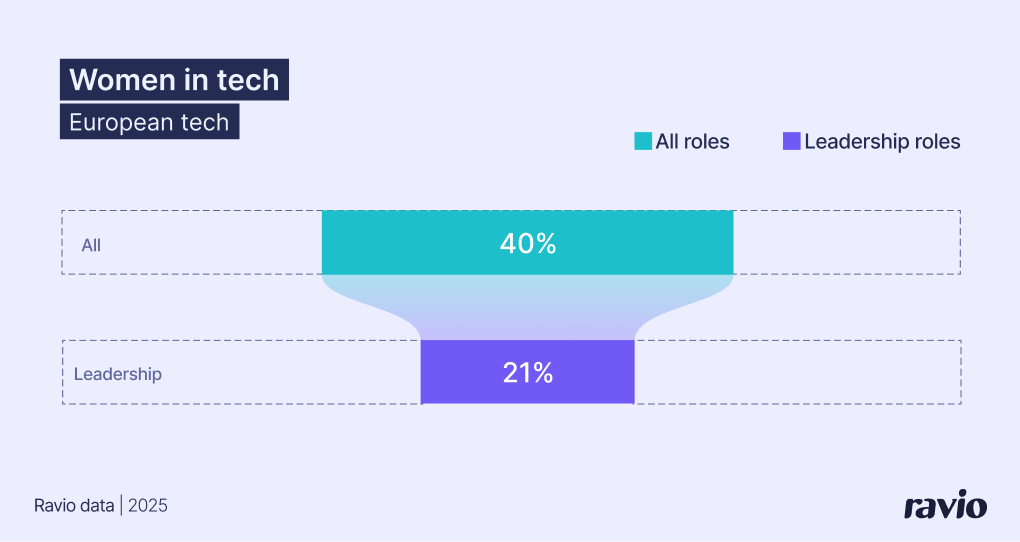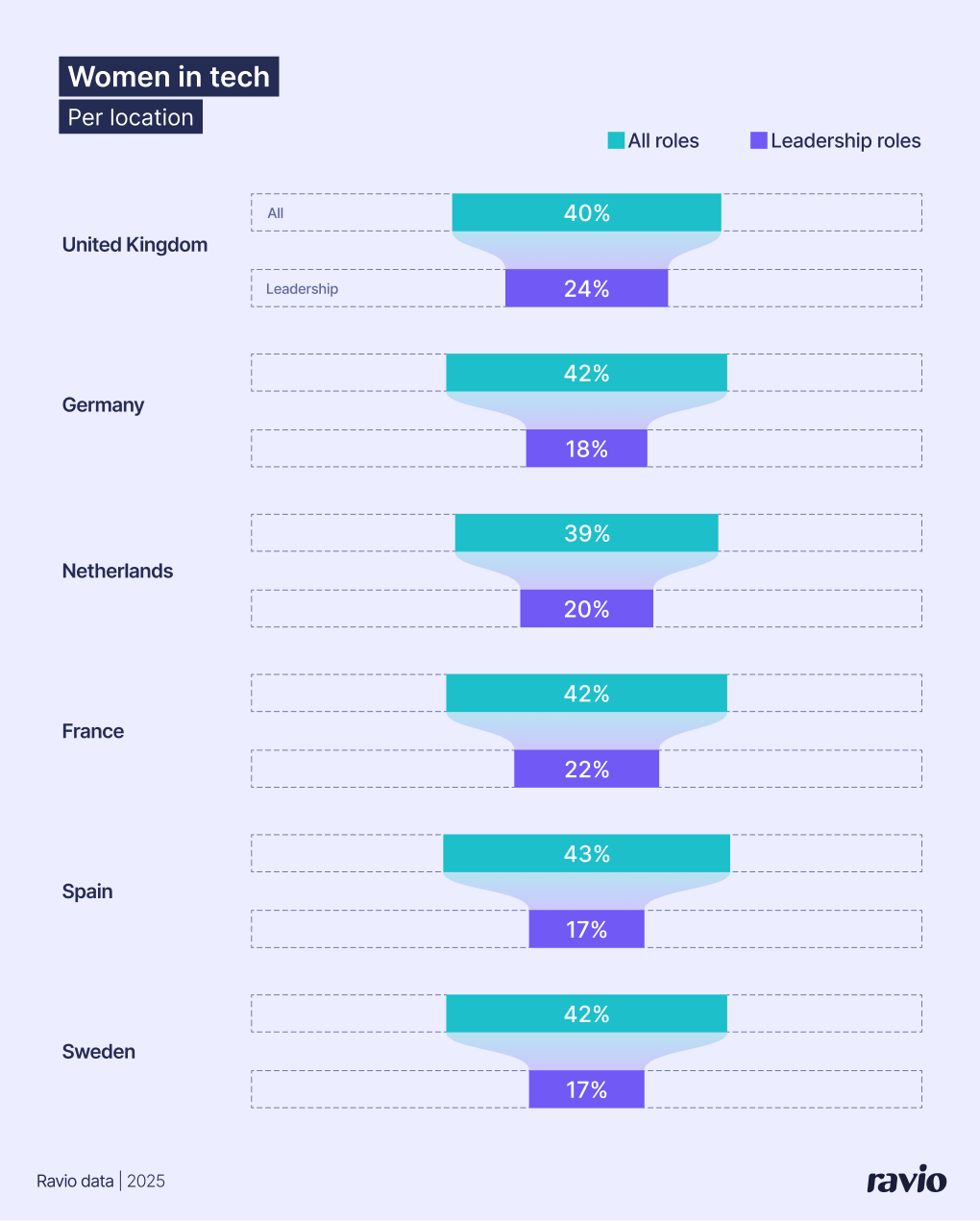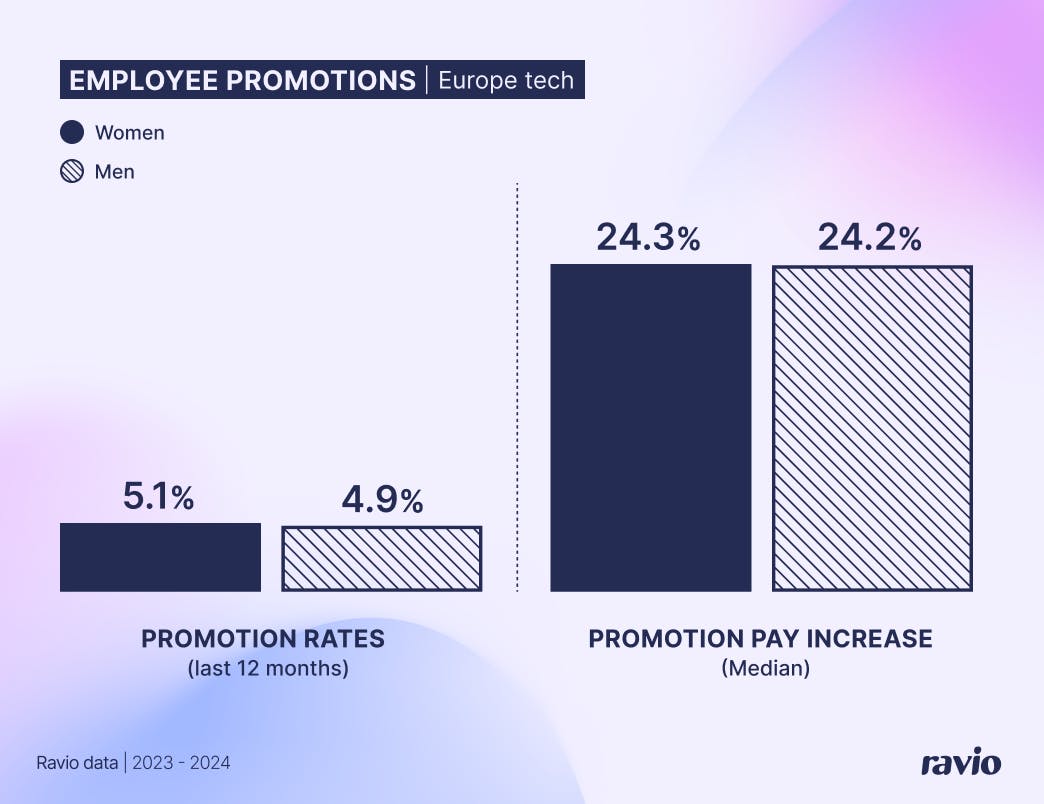Women's underrepresentation in tech, particularly at leadership levels, is the primary driver of pay equity issues in the tech industry.
With fewer women in senior, higher-paying roles, the overall earnings gap between men and women widens – creating the 23% unadjusted gender pay gap that persists across the industry in 2025.
For HR and Reward Leaders, this presents both a practical and compliance challenge.
Pay equity has always been foundational to the function – ensuring fair, consistent compensation decisions across the organisation.
But it’s now a compliance issue too. With legislation like the EU Pay Transparency Directive coming into effect, representation moves from being just a diversity metric to a regulatory risk.
Let’s take a look at the latest Ravio data on the representation of women in tech, to see where women stand in the workforce and leadership in 2025, why representation remains persistently low, and what's driving the barriers that keep women from reaching senior roles.
What is the representation of women in tech in 2025?
In 2025, women make up 40% of the overall tech workforce, as per Ravio’s Compensation Trends report.
The representation of women in the workforce (and, as we’ll see, especially at senior levels) is one of the key drivers of the gender pay gap in European tech – if we don’t tackle the representation problem, we can’t tackle pay inequity.
"I’m seeing companies publishing their data and checking the compliance box, but not addressing root causes. Transparency alone doesn’t fix systematic pay equity issues – it’s the promotion patterns, role levelling inconsistencies, negotiation biases, and so on that we need to look deeper into.”

Director at FNDN
What proportion of tech leadership are women in 2025?
If we look at the representation of women in leadership positions in the tech industry, women hold just 21% of executive roles – 79% of leadership positions are held by men.
This leadership gap is where representation becomes a structural pay equity problem.
Executive positions naturally command significantly higher salaries than lower-level roles, so having nearly four times as many men as women in these positions creates a substantial earnings imbalance between genders overall.
Even when companies pay men and women equitably for the same role at the same level, the sheer concentration of men in senior, higher-paying positions drives the unadjusted gender pay gap. Without improving representation at leadership levels, closing the overall gender pay gap becomes nearly impossible.
How does the representation of women in tech vary across Europe?
The overall representation of women in tech is fairly consistent across European tech markets, ranging from 39% in the Netherlands to 43% in Spain. This suggests that baseline efforts to bring women into the tech workforce have achieved similar results across different countries and regulatory environments.
However, there's significantly more variance when it comes to women in tech leadership positions.
The UK leads Europe with 24% of executive roles held by women – though this still represents less than a quarter of leadership positions. At the other end, Spain and Sweden tie for the lowest representation, with just 17% of senior leaders identifying as women.
Germany sits at 18%, France at 22%, and the Netherlands at 20% – all below the European average of 21% female leaders.
Sweden's position is particularly striking.
Despite the country's progressive reputation and strong gender equality policies in other sectors, Swedish tech companies have just 17% women in leadership – tied for the lowest in Europe. This suggests that achieving modest female representation at entry and mid-levels decades ago may have created complacency, with companies stopping their push for genuine leadership diversity whilst resting on their progressive credentials.
"Efficiency and profitability are still dominating the executive agenda, and whilst HR teams know they need to prioritise pay transparency, they're also waiting to see how their countries will translate the EU Directive into local law. But what companies should be hyper-conscious of is that the next compensation review (likely Q1 2026 for most) will be their last chance to fix pay gaps through the normal cycle before transparency requirements come into effect."

Senior Compensation Manager at Bolt and Co-founder of Cohorts
Why is female representation in the tech industry still so low?
According to Ravio's Pay Equity Report, three interconnected barriers keep women underrepresented in tech, particularly at senior levels:
- The pipeline problem that starts before women even enter the industry
- Hiring practices that introduce inequality from day one
- Workplace cultures that make it difficult for women to progress into leadership roles.
1. The talent pipeline problem starts before employment
Tech has historically been a male-dominated sector, creating a cycle where limited role models discourage women from pursuing tech careers.
Women are typically underrepresented in tech education pathways and university courses well before they enter the workforce – by the time companies are recruiting, the talent pool is already skewed, making diverse hiring extremely difficult even for organisations committed to gender balance.
💡 How can tech organisations improve the gender diversity of their talent pipeline?
- Partner with organisations like Women in Tech that work to improve visibility and accessibility of tech careers for women
- Offer internships, apprenticeships, and mentoring programmes specifically targeting women in STEM education
- Send female employees to speak at schools, universities, and career events to provide visible role models
- Support coding bootcamps and career-switching programmes that help women transition into tech from other industries.
2. Hiring practices introduce inequality at point of entry
Ravio’s data shows that men and women have similar rates of promotion (around 7-8%) and pay increases once employed.
This means gender pay inequality must exist from the start of employment – the problem is at the door, not in internal progression.
Unconscious bias in hiring can introduce pay disparities through several mechanisms: systematically lower salary offers to female candidates, negotiation dynamics that disadvantage women, and recruitment practices that rely heavily on male-dominated networks rather than broadening the candidate pool.
💡 How can tech organisations improve hiring practices for gender diversity?
- Implement policies requiring diverse candidate pools for every role, particularly senior positions
- Use reliable benchmarking data to make objective compensation decisions, to eliminate bias in salary offers
- Remove questions about salary history from the interview process – using past salaries to set new offers only perpetuates existing gaps
- Train hiring managers on unconscious bias and ensure diverse interview panels
- Broaden recruitment beyond existing networks by posting roles on platforms specifically targeting women in tech.
3. Male-dominated culture limits progression to leadership
Even when women enter tech companies in reasonable numbers, many struggle to progress into senior positions.
Male-dominated workplace cultures can make it difficult for women to visualise themselves in leadership roles when there are so few female executives to look up to.
This challenge is compounded by the reality that women still shoulder disproportionate caregiving responsibilities.
Research shows that mothers are much more likely than fathers to reduce working hours or withdraw from full-time employment after having children. When senior roles lack flexibility and require intense time commitments that conflict with caregiving, women face an impossible choice between career progression and family responsibilities.
💡 How can tech organisations support women in leadership?
- Hire and promote female leaders deliberately – implement hiring policies that prioritise diverse leadership candidates
- Ensure senior roles offer genuine flexibility, not just token remote working options
- Provide equal parental leave for all genders and actively encourage men to take it, normalising caregiving as a shared responsibility
- Create sponsorship programmes where senior leaders actively advocate for high-potential women's advancement
- Address toxic workplace behaviours quickly – take reports of discrimination or harassment seriously and implement preventative policies.
FAQs
How many women are in tech?
Women make up 40% of the European tech workforce in 2025, according to Ravio's 2026 Compensation Trends report. However, this representation drops significantly at senior levels, with women holding just 21% of executive positions across European tech.
What proportion of tech leaders are female?
Women hold 21% of executive roles in European tech in 2025, according to Ravio's 2026 Compensation Trends report. This varies by country, with the UK highest at 24% and Spain and Sweden lowest at 17%. The significant gap between overall workforce representation (40%) and leadership representation (21%) demonstrates the "leaky pipeline" challenge facing the industry.
Why are there fewer women in tech?
Women are underrepresented in tech due to three main factors: limited exposure to tech careers and role models during education, hiring practices that introduce pay and representation gaps from day one, and male-dominated workplace cultures that make it difficult for women to progress into senior positions.
How can we attract more women in tech?
To attract more women into tech, companies should partner with organisations that promote tech careers to women, offer mentoring and internship programmes targeting women in STEM, ensure diverse candidate pools for all roles, use objective compensation frameworks to eliminate hiring bias, and provide visible female role models throughout the organisation.
Why do we need more women in tech?
Improving women's representation in tech is essential for closing the gender pay gap, meeting regulatory requirements like the EU Pay Transparency Directive, and ensuring fair compensation practices. Women's underrepresentation, particularly in leadership, is the primary driver of pay inequity in the industry.
How can we support women in tech?
Companies can support women in tech by ensuring genuine flexibility at all levels (not just junior roles), providing equal parental leave and encouraging all genders to take it, creating sponsorship programmes where senior leaders advocate for women's advancement, and addressing discriminatory workplace behaviours quickly with clear policies.






